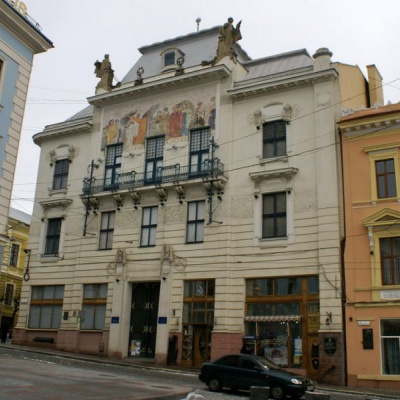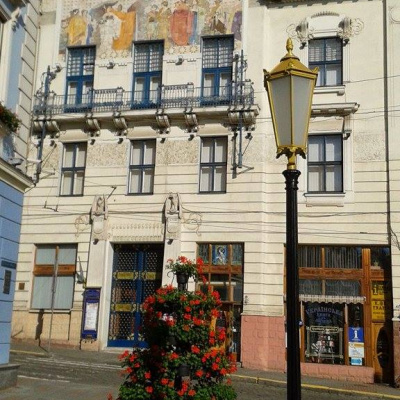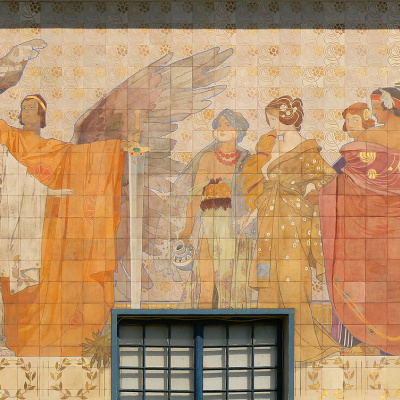Art Museum, Chernivtsi
One of the best museums in Bukovyna today is the Chernivtsi Art Museum. Visiting it, you will be able to get acquainted with the art and folk art of the region, discover new names and folk styles. The Chernivtsi Art Museum is an art museum in Chernivtsi, the only museum in Bukovyna with a valuable collection of regional Ukrainian painting.
The historic building with well-preserved interiors of the early 20th century, which houses the museum, is a nationally significant architectural monument made in the Viennese Secession style. The Chernivtsi Art Museum is located on the second and third floors of this magnificent historic building in the heart of Chernivtsi at: Central Square, 10, Chernivtsi 58000 (Ukraine). The current director of the institution is Inna Kitsul.
The building of the Chernivtsi Art Museum is a unique architectural monument of national importance, built in the tradition of Viennese Secession in the Art Nouveau style for the Bukovyna Savings Bank (1900) by architect Hubert Gessner together with Prokop Šupich (1870-1947). The building was constructed by Robert Vitek (1871-1945). The exterior and interiors of the building, made during its construction, have not undergone significant changes over time, and now form part of the sightseeing tour.
The main façade features a risalit with a balcony on consoles and a magnificent majolica panel above the balcony, created by the artist whose signature "J. Lan(g?)" is indicated in its lower part (Joseph Adolf Liang). The complex polychrome composition on mythological themes draws a parallel between the Roman Empire and Austria-Hungary under Franz Joseph I. The 12 gods represent the 12 most important provinces of the empire, which embodied its essence. On the panel, the gods are arranged in picturesque groups in accordance with the basic principle of Art Nouveau: dynamic balance instead of mirror symmetry.
Thereare two female sculptures on the roof above the cornice. At the level of the second floor windows, the house is decorated with a frieze in the form of picturesquely scattered leaves, which was once covered with gilding. The windows are decorated with stucco moldings. The doors of the main entrance are forged metal double-leaf doors with floral ornaments and horizontal inserts depicting bees. On the pylons on either side of the door are sculptural images of two eagles that seem to guard the entrance to the building.
The building has an extremely expressive interior. The ground floor lobby is decorated with six majestic columns. At the beginning of the main staircase there are two pylons culminating in male and female busts on curly pedestals. Wide staircases framed by forged lattices with floral and ornithomorphic ornaments lead from the first to the second and third floors. The stairwells between the floors are decorated with large stained-glass windows with floral motifs - images of bright flowers and green leaves. One of the stained-glass windows on the third floor features the ancient coat of arms of Bukovyna (a rook's head on a blue and red field framed by three six-pointed stars). In 2011, a large-scale restoration of the interior stained-glass windows was carried out. In the center of the second floor lobby are four columns and a trapezoidal marble fireplace decorated with wrought copper and floral ornaments. The space of the second and third floors is united by an oval opening decorated with relief ornamentation and wrought iron grilles identical to those on the staircase. The contours of this opening are repeated in the oval picturesque ceiling lamp on the third floor. This large allegorical composition on canvas with images of female figures and putti differs somewhat from the rest of the decor, being closer to academic art in its stylistic features. It is attributed to the famous Ukrainian Bukovyna artist Mykola Ivasiuk (1865-1937).
The color scheme and ornamentation of the walls, doors, and mosaic polychrome floor, the harmonious combination of skillful forging, stained glass, and sculpture create the impression of a complete work of art, expressing the main idea of the Art Nouveau style.
The Chernivtsi Art Museum was established in 1988 on the basis of the art department of the regional museum of local lore. Objects from the funds of this institution formed the basis of the collection of the newly created institution. Later, the museum collection of the Chernivtsi Art Museum was replenished with artifacts collected during expeditions and works transferred by the Directorate of Art Exhibitions of the Ministry of Culture of Ukraine, as well as charitable gifts to the museum from individual artists and patrons. The museum's first exhibition was opened in 1988 in the then defunct St. George's Cathedral.
Since 1991, the Chernivtsi Art Museum has been housed in its current building. In 1996, after a large amount of restoration work, a stationary exhibition was opened, which for the first time represents the fine and religious art of Bukovyna and the ornamental art of the region of the XVII-XX centuries.
The staff of the Chernivtsi Art Museum is the author of numerous publications on art, including scientific publications, a number of catalogs and booklets about the works of Bukovyna artists. During the museum's existence, a significant number of exhibitions have been organized, a number of projects have been developed, and a series of annual vernissages have been developed, which become interesting artistic events and events in the cultural life of the city and the country. The exhibition work of the Chernivtsi Art Museum is closely connected with scientific and educational activities.
In total, the museum's collection includes more than 12 thousand exhibits. Most of them represent the art of Bukovyna of the 17th-20th centuries. The permanent exhibition of the Chernivtsi Art Museum includes the following collections:
- Collection of Bukovyna iconography of the 17th-20th centuries. These are Bukovinian domestic images, icons on glass, valuable works of folk and professional iconography, etc. Among the painters of the eighteenth and nineteenth centuries are the names of E. Grützner, E. Buchevsky, and A. Kohanovska.
- The art of Bukovyna in the 20th century. The fine arts of 20th-century Bukovyna are represented by paintings by E. Lipetskyi and A. Kolnyk, collections of works by I. Beklemisheva, O. Kyselitsa, E. Neiman, P. Yakovenko, L. Kopelman, O. Kryvoruchko, Y. Zayets, as well as works by I. Kholomeniuk, O. Plaksii, V. Sanzharov, O. Liubkivskyi, and others.
- Works of Ukrainian artists of the 20th century: The museum collection reproduces the works of individual Ukrainian artists of the 20th century - M. Hlushchenko, M. Derehus, A. Kotska, S. Shyshko, H. Havrylenko, I. Ostafiychuk, etc., as well as artists of the Bukovynian diaspora - Petro Megyk, Temistokl Vista, Mykola Bidnyak, Stefan Papp.
- Ornamental Art of Bukovyna, which presents artistic examples of traditional Bukovynian art.
- Works of the Bukovinian diaspora: Petro Mohyka, Mykola Bidnyak and others.
- The museum houses a rare collection of Bukovyna folk carpets(a similar collection is also in the museum of carpet weaving in the village of Nahoryany), more than 3000 Bukovyna and Hutsul Easter eggs, works by wood carvers Vasyl and Mykola Shkribliak, M. Megedeniuk, and the works of H. Garas, M. Kateryniuk, and others.
In general, the collection of the Chernivtsi Art Museum successfully represents the folk and fine arts of Bukovyna over the past 300 years.
Initially, the museum existed as a department of the regional museum of local lore, and they shared the same premises. It was not until 1988 that the museum was opened as an independent unit. Initially, it was housed in the then non-functional Sviatodukhiv Cathedral. However, it was soon given to the community, and the museum gradually moved to its current building next to the city hall. The building itself is a magnificent work of art, and the mosaic on top of the facade is visible to everyone around. The building was constructed in 1900-1901 for the Savings Bank.
Today, the collection of the art museum is replenished mainly by patrons and local collectors. The museum hosts numerous exhibitions, cultural events, and master classes.
The museum is located at 10 Tsentralna Square, in the heart of the city. Chernivtsi is conveniently accessible by rail from Lviv, Kyiv, Odesa, or by private car.
Museum opening hours: 9:00-17:00 every day except Monday.
Entrance fee: adult ticket: 15 UAH, student ticket: 10 UAH, children's ticket: 7 UAH.
Chernivtsi is the capital of Bukovyna. One of the most beautiful and pleasant Ukrainian cities. Here is one of the most beautifulrailway stations in the country, theChurch of St. Paraskeva of Serbia, the Church of the Exaltation of the Cross, the house-ship, the City Hall (every day at 12:00 a trumpeter plays the melody of "Marichka" from the tower), the Art Museum, then Kobylyanska Street, the German Folk House, the Armenian and Assumption Church (the oldest stone Ukrainian Greek Catholic Church in Chernivtsi), the Theater Square and the Kobylyanska Theater. Kobylianska Theater Square, Jewish People's House, Chernivtsi University (included in the UNESCO World Heritage List), Turkish Square (Chernivtsi has been a part of Turkey, Modova, Romania, Austria-Hungary, the USSR, Rus, and Ukraine), and a large rover,cozy streets and cobblestone streets, the so-called Drunken Church, Nazariy Yaremchuk's house, then another house-ship, two houses with the same number (Olha Kobylianska lived here), the house where Volodymyr Ivasyuk lived, the pink church - the Cathedral of the Holy Spirit.
Chernivtsi sights
- St. Nicholas wooden church (from 1607, restored in 1954);
- stone Church of St. George on the Bitterroot (1767 in the Baroque style);
- wooden Trinity Church in Muggles (one thousand seven hundred and seventy-four), moved in 1874 to Kłokuchka;
- wooden Assumption Church on Kaleczanka (1783);
- City Hall with a two-story, 45-meter-high Empire-style tower (1843-1847, architect A. Mykulych), now the City Council;
- Ukrainian Greek Catholic Church (1825-1830 in the Baroque style);
- Byzantine-style cathedral (1844-1864, architect Roll);
- Church of St. Paraskeva in the pseudo-Romanesque style, completed in 1662 (architect A. Pavlovsky);
- residence of Bukovyna metropolitans - since 1956 one of the buildings of Chernivtsi University);
- Armenian Gregorian Church (1869-1875, architect J. Hlavka);
- Chernivtsi University building (1874-1875);
- Jesuit church in the Neo-Gothic style (1893-1894);
- Railway station (1898-1903) in the Art Nouveau style;
- the City Theater (1904-1905, architects F. Fellner and G. Helmer) in the Viennese Baroque style with Art Nouveau elements (now the O. Kobylianska Music and Drama Theater), etc.









